Creating loading flash drives from ISO Linux. Create a boot USB disk with Windows from under Linux
Boot flash drives will always be useful. The computer broke, the OS slowly works, it is necessary to install Linux ... there are thousands of such situations, and the solution is one. In this article, we will look at how to make a Linux bootable flash drive.
RUFUS is the most common and secure option. The second followed by Ultraiso - when any problems occur, it is necessary to use it. Well, and if he did not help - then he will come to the aid of UnetBootin.
We make the loading flash drive via RUFUS
RUFUS - a Windows program that allows you to create boot disk, Including Linux. In order to create a bootable flash drive, first download RUFUS. Now it is necessary to download the desired Linux distribution in the form ISO Imagebut. After the download is completed, you run the program.
All parameters remain the default, just choose the disc needed to us and instead of Freedos select the ISO image and specify the path to it to the right button to the right. For instance, installing Ubuntu. 16.04 will look like this:

Click "Start". Everything! Now you have your own boot flash drive. About how to run it, read below.
We make a loading flash drive via UnetBootin
UnetBootin is a cross-platform application designed to create Linux distribution disks. You can download it.
In order to create a bootable flash drive, there are two ways. First - select the distribution in the list from above:
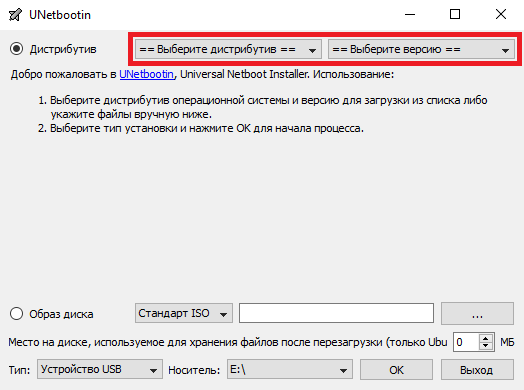
The second way is to download the image and select it in the bottom field:
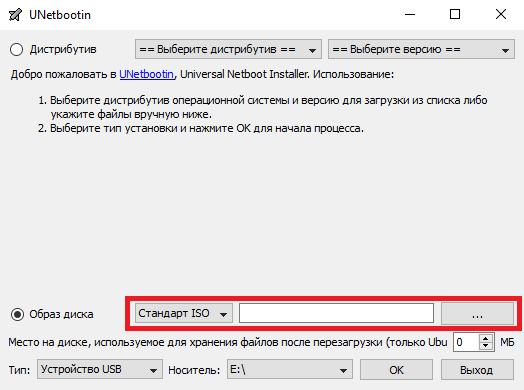
After selecting, click "OK". Will go to install boot flash drive.
Important! Better to download the ISO-image of the system itself, otherwise the program does not guarantee her novelty and relevance!
Creating a bootable flash drive using Ultraiso
Ultraiso - paid program To work with ISO images. To create a loading flash drive, you can use trial version programs.
Download the program from the official site. After installation, choose the use of a test 30-day period.
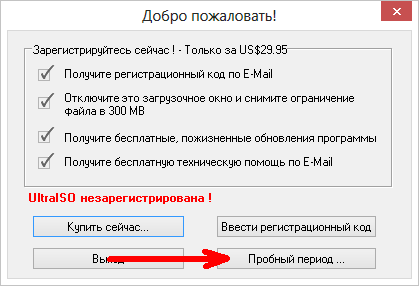
Now open the downloaded ISO image in advance:
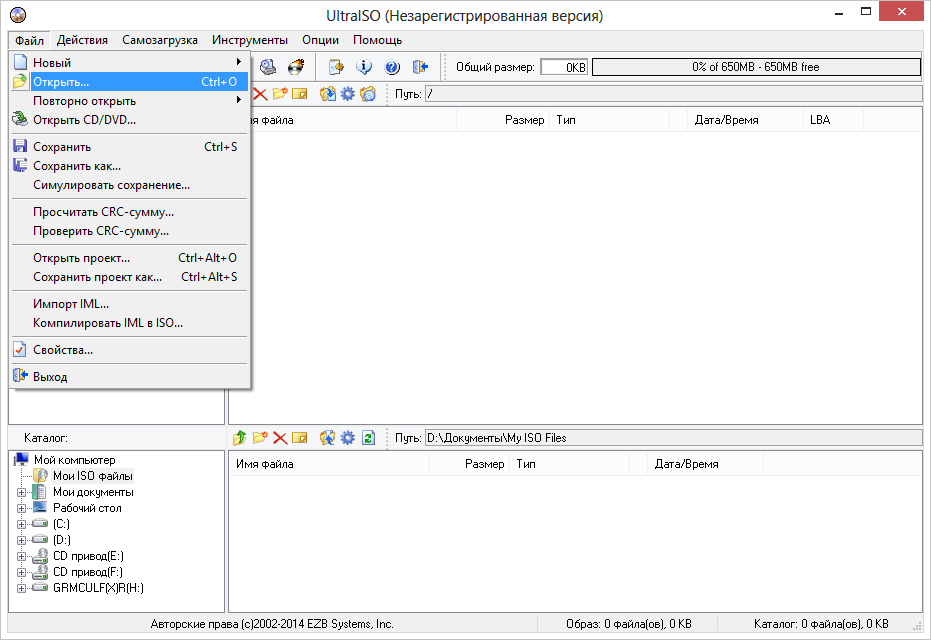
To create a boot flash drive, you need to find the "Self-loading" menu and select the item "Write a hard disk image" in it:
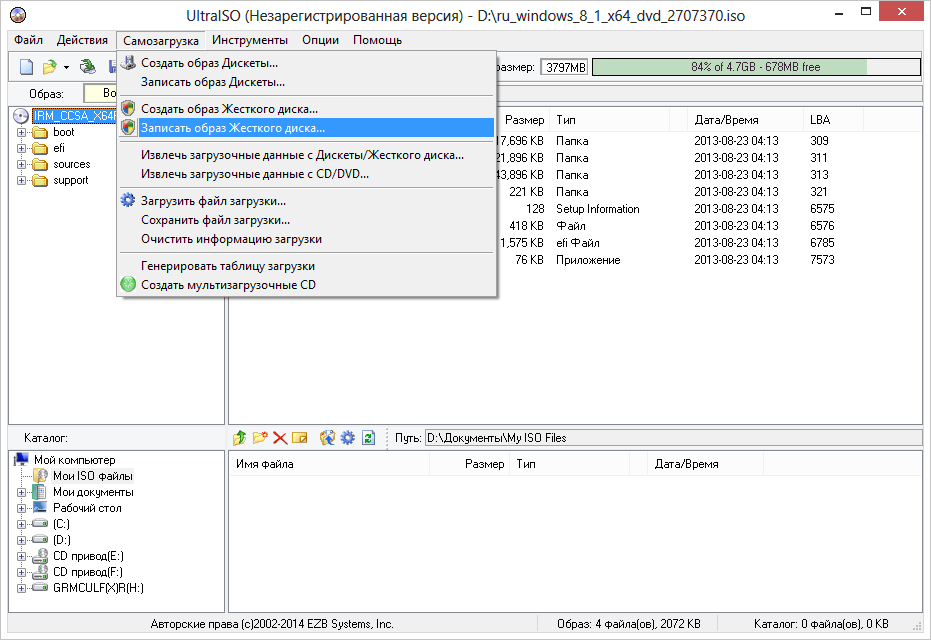
Here you choose discAlso choose the USB-HDD + V2 recording mode - it guarantees the work of the flash drive in almost any BIOS:

Click "write down". A warning of formatting flash drive will appear. Click "OK".

Everything, the process went. We are waiting for the end of the entry.
How to boot from a flash drive via BIOS
To start the BIOS, use one of the following keys (specified in the order of reducing the probability of triggering).
- Delete.
Important! If you have lenovo laptop, Try to use the combination of Fn + F12!
Optical disks are the last century. As well as floppy disks and other similar drives. Now rolls flash drives and external discs. It is convenient to use them to install systems, because today we will look at how you can use a USB flash drive to install the Ubuntu distribution with it. We also consider the methodology for creating such a flash drive in the Windows 10 operating system (although it works for earlier OS).
Creating a boot flash drive using the RUFUS utility
The program itself can be downloaded by reference. Last version Distribution Ubuntu -.
- Connect the USB flash drive and run the program:
- Select a flash drive to which will be recorded:

- Check the checkmarks: "Fast formatting", "Create a boot disk", then in the drop-down list Set the ISO image:

- Select a Ubuntu image or another distribution using the:

- Click the Start button to start recording:

It remains to wait for the end of the overwriting and restart the computer.
Creating a boot flash drive using UnetBootin utility
- Select the Select Image button. The desired image:

- The Flash button is written. And no detament :)
Creating a bootable flash drive using Ultraiso
This is an already more serious, multifunctional and paid program. Take. She knows how much, but now we are interested in recording the image of the flash drive.
- Connect the USB flash drive and run the program.
- Select Self-loading-\u003e Record the image of hard Disc:

- In the window that appears, you must select the image file and logical disk Your drive.
Of course, these are not all utilities. There are still many interesting things, however, for a start, we believe it is enough. Not far away, we, how to put Ubuntu by steps.
Operating users windows systems Can very easily create a loading flash drive with the Ubuntu image on it. To do this, you can use special software.
To record Ubuntu, you need to have an ISO image of an operating system, which will be stored on removable media, as well as the drive itself. It is important to understand that all data will be erased on the USB carrier used.
Before creating a bootable flash drive, download the distribution of the operating system itself. We recommend doing this solely on the official website Ubuntu. This approach has many advantages. The main one lies in the fact that the downloaded operating system will not be damaged or flawed. The fact is that when downloading the OS from third-party sources, it is likely that you load the image converted by someone.
If you have a flash drive from which you can erase all the data, and the downloaded image, use one of the ways listed below.
Method 1: UnetBootin
This program is considered the most basic in writing questions to Ubuntu for removable media. It is used most often. How to use it, you can read in the lesson on creating a boot drive (method 5).
Paragraph 3 in LinuxLive USB Creator We skip and do not touch.
As you can see, the program has a fairly interesting and non-standard interface. This, of course, attracts. A very good move was to add a traffic light near each block. The green light on it means that you did everything right and vice versa.
Method 3: XBoot
There is one more very unpopular, "unwrapped" program that perfectly copes with the record of the image of Ubuntu on the USB flash drive. Her great advantage is that xBoot is able to add not only to the bootable media operating system, and also additional programs. These can be antiviruses, all kinds of utilities for launch and the like. Initially, the user does not need to download the ISO file and this is also a big plus.
To use XBoot, follow these actions:

So, create a bootable USB flash drive with the image of Ubuntu windows users very easy. It can be done literally in a few minutes and even a beginner user will be able to cope with such a task.
In this article, I will consider the process of creating a boot USB flash drive (LiveUSB) in operating systems - Linux, Windows and MacOS. On the USB flash drive I will record the ISO image of the Linux distribution, but you can use the program described below to record any Live images.
As a rule, before the user, the task is to write the ISO image on the flash drive to get LiveUSB as a result. For example, you decided to install Ubuntu. To do this, you download the ISO image with the system, write it on the USB flash drive, load from the flash drive, and the Live system or installer starts.
To boot from the LiveUSB flash drive you should in the BIOS settings of your computer, install the USB boot to the first place. For many motherboards When you turn on the computer, you can call a menu in which you can select from which device to load. In this case, change bIOS settings not required. I, for example, this menu is called by pressing the key F12..
Creating a bootable flash drive (in Linux, Windows and MacOS)
To create a boot flash drive, I will use free program Etcher.. It is very simple and clear program. Creature boot media It is made extremely simple.
The program cross-platform and with its help you can create bootable flash drives in Linux, Windows and MacOS. In all systems, it works equally.
The program can be downloaded from the official site https://etcher.io
Note: In Linux installation is not required, just download the file eTCHER-1.2.3-X86-64.appImage And launch it.
Consider the process of creating a boot flash drive in the Etcher program.

Video - How to create a bootable USB flash drive in Etcher
Creating a bootable flash drive in the UnetBootin program
Under Linux there is a fairly popular program UnetBootin.which allows you to create bootable flash drives. It knows how to record disk images, as well as automatically download images of popular Linux distributions (really available for download, very old versions of distributions are available, so this function is unlikely to be useful for you).
The cross-platform program and can be used in Windows and MacOS. I tested it only under Linux. But she has one big drawback! Some flash drives created by it are tritely refused to load. For example, I have nothing worked until I formatted a flash drive in FAT16. The USB flash drive formatted in the Gparted program, the size of the partition on the flash drive was automatically installed in 4GB, the rest of the free space was simply not involved.
The process of creating a bootable flash drive in UnetBootin is described below.

Possible problems
Missing Operating System Error
If you receive a message during the computer download Missing. Operating System. "Most likely the flash drive has no flag Boot.. To install it restart your computer and log in to your system. After that, run a command in the terminal (the flash drive must be connected):
PARTED / DEV / SDB SET 1 BOOT ON
Now restart the computer again.
No Default Or UI Configuration Directive Found Error
I encountered another error while downloading a computer - "No Default or UI Configuration Directive Found". It was possible to solve this problem only to format a flash drive in FAT16 and repeatedly creating LiveUSB.
Video - How to create a bootable USB flash drive in UnetBootin
To begin with, it is necessary to figure out the very concept of the Linux boot flash drive? This topic Very popular, you can find almost everything on the Internet.
Option number 1. Creating a bootable flash drive in UnetBootin
UnetBootin is a program for installations Linux without CD / DVD.
This utility allows you to install on your computer or otherwise, create a bootable Flash disk with special Linux / BSD distributions downloaded earlier from the Internet.
The installation can be manufactured both through Windows and via Linux.
The program is installed on most Linux distributions, namely: Ubuntu, Fedora, OpenSuse, Centos, Debian, Linux Mint., Arch Linux, Mandriva, Slackware, Freedos, FreeBSD, NetBSD and their varieties).
- Before proceeding with this utility, you need to format a USB drive, best to elect file System FAT32. How to perform it, shown in the following illustration:

- After cleaning the Flash media, you need to run the UnetBootin program. As already mentioned, this program allows you to record Live CD / DVD from the Internet, showing only the distribution and its version:

- To record the disk image of the operating system (in the example, the Distribution Distribution - Debian Wheezy, you can find any other) to a USB drive, select the item - "disk image", then activate the "ISO Standard", also do not forget to specify the path to the distribution with the expansion .Iso, and also specify the type of device and the carrier itself (as shown in the figure).
Characteristics are selected, now it is necessary to press the "OK" button, the procedure for extracting and duplicating files is automatically. This process It will take 5-10 minutes.

- At the end of the unpacking the necessary files, the program will automatically install the bootloader and will report when the loading flash drive is ready.
If you wish, you can immediately install the Linux OS, for this you need to restart the computer and select the system to load the system via USB media.

If the installation is not required, then the computer restart does not make sense, you should click on the "Exit" button. Everything! As you can see, it is completely not difficult.
Your loading flash drive Linux is ready to work.
Option number 2. Creating a bootable flash drive in Universal USB Installer
Unlike the first, this program is formatted by removable media spontaneously.
let's consider this program in details.
- You need to install and run the UNVERSAL USB Installer program.
- At the first stage, a list of Linux operating systems is shown. We choose the Linux you want to use on the flash drives if you do not need, then specify "Try Unlisted Linux ISO".
- The second step is to the pre-downloaded Linux distribution on your computer, if you did not select the folder on your own, then look for it in the folder - download.
- We specify our flash drive, usually H a disk, after which your device is coming.
All check again and press the "CREATE" button.

- Next, a warning will appear, on the closure of all unnecessary windows, close everything and click hereinafter.
The program will automatically format the USB drive, will form the loading area of \u200b\u200bthe MBR, modifies the volume label to the UUI name and set the image of the operating linux systems. We only need to confirm the action by clicking on the "Yes" button.

- After there is a procedure for installing data to removable media, as shown in the figure, literally after 5 minutes everything will be ready.

- The program independently completes the installation process, we look at the figure below.

That's all, the next loading flash drive Linux is created!
Option number 3. Creating a loading flash drive XBoot utility
In this case, the creation option is considered using the XBoot utility.
This program does not require installation on a computer, you can run it immediately after downloading from the Internet.

The interface of this utility is quite simple.
To add images to be transferred to ISO files (Linux distributions) of each image to the main part of the program window, or click on File Open, as shown in the figure.

After the path to the image is specified, the window will open, with the question: how to perceive this image?
Since we make the loading USB flash drive for Linux, select Utilitu - Ubuntu, but if you make a flash drive under Windows !! Select Add Using Grub4dos Iso Image Emulation.
Consider, the item is standard for adding Windows.

A huge plus of this program, which, together with the system on the loading USB flash drive, you can install various antiviruses, such as: Dr.Web, Live CD, Kaspersky Rescue Disc.
In the future, they will help protect the computer from Trojanov, viruses and other nastiness.

Utilities that come complete with the program
As shown in the figure above, the program offers various utilities for both Linux OS and for Windows.
XBoot is not installed on the computer, so all the utility you selected will be downloaded automatically from the Internet, you will need only to confirm all actions, all steps are shown in the pictures.


To make it convenient to work with images, write your name for each. For example: Linux 1 WT, Linux 2 Mouse, Linux 3 Android.

Check all the steps again when everything is ready and if you are sure that you have not missed anything, you choose the item to record on USB drive (Do not confuse to make boot DVD Disc), Before use, you need to clean the flash in FAT32.
If you do not know English, then find two buttons at the bottom of the window, when you press the CREATE ISO button, you will make a boot DVD, but we need to press - CREATE USB.


When you press the CREATE USB button, the window will pop up with a choice of a gadget USB, to write and select the bootloader, will automatically stand SYSLinux recommended for the current work.
If an error drops out, then change the loader to Grub4dos, it is fully supporting formatting in NTFS.
Before pressing the OK button, it is necessary to check exactly and carefully, whether the media was selected so that the desired information from the portable hard disk is not deleted by mistake.
After clicking on OK, the same image creation will occur as when creating an ISO.


At the end of the download from this flash drive, an overview of the convenient menu jumps.
Here you can install the necessary operating system for the current computer, check hard disks to the presence of viruses and much more.
All these utilities you yourself choose, when creating a flash drive!

I hope our article helped you and now, you know what the loading flash drive is and most importantly, how to create it!
For more information with the topic you can watch the video on YouTube:
Creating a bootable flash drive with Linux Mint 17.2 Rafaela
Linux loading flash drive - Best options Create

 entrance
entrance